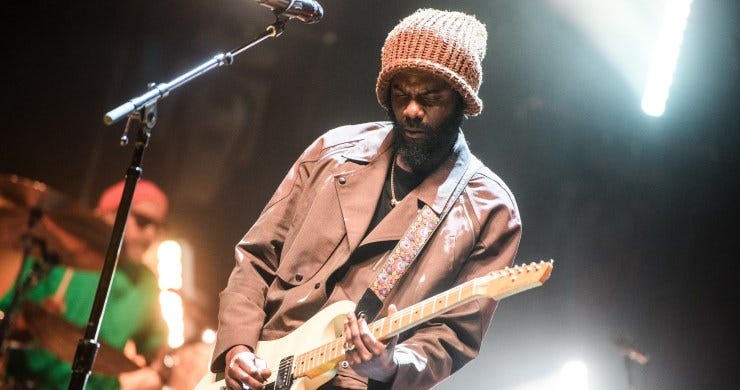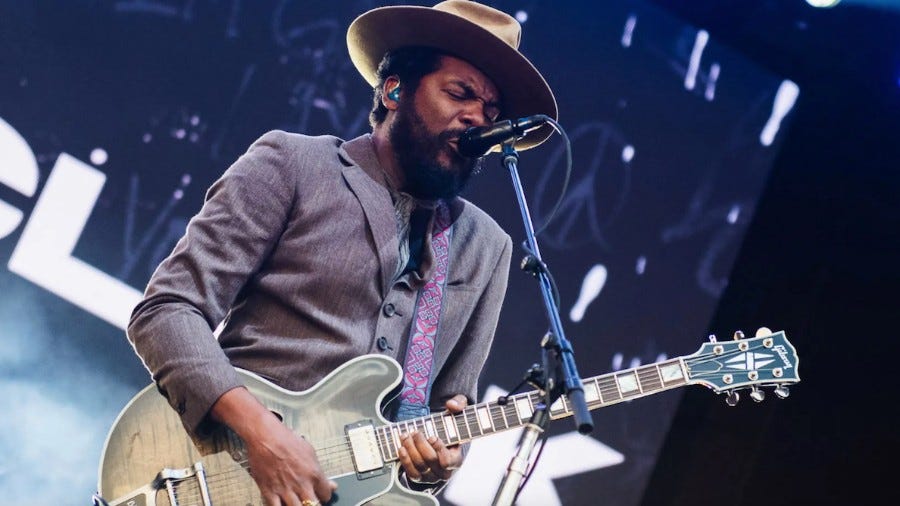
A few weeks ago I had the pleasure of seeing Gary Clark Jr. perform at Radio City Music Hall in Midtown Manhattan (thanks James)! Since then, many of my guitar students have been curious about what makes him stand out in comparison to other guitarists. I’ve been lucky enough to see him perform live four times over the past 11 years. Below, I share the concerts I’ve seen and the moments from them that have stuck with me over the years. Later, I list techniques that I believe are most crucial to Gary’s playing style that anyone can start incorporating into their guitar playing immediately.
November 6, 2012 - Brooklyn Bowl, Brooklyn, NY. During election night, Gary blasted through an epic solo on “Bright Lights” as the results of President Obama’s victory appeared on the screens around the venue. See the performance here (you can hear cheers for the results and for the jam starting around 11 minutes in).
November 16, 2013 - Terminal 5, New York, NY. Gary’s first tune of the encore during this show might have been the best solo performance I ever witnessed! So much soul, so much feeling. He played a one-of-a-kind blues guitar and harmonica arrangement of Leroy Carr’s tune “In The Evening When the Sun Goes Down,” which was first recorded in 1928 and has since been performed by many music legends, including Ella Fitzgerald, Ray Charles, and Etta James.
March 19, 2017 - Madison Square Garden, New York, NY. Gary Clark Jr. and Jimmy Vaughn open the show for Eric Clapton. See Gary performing the crowd-pleaser, “When My Train Pulls In” on this night.
June 11, 2024 - Radio City, New York, NY. “What About the Children” is a song from Gary’s latest album JPEG RAW, featuring Stevie Wonder. I hadn’t heard it before this performance, and I distinctly remember it being one of my favorites of the night.
In an interview with Ultimate Guitar, Gary explains that his sound and style comes from playing clubs in Austin, Texas, especially Antone’s, a legendary blues club, where he met and played with blues musicians like Jimmy Vaughn and Hubert Sumlin as a teenager. Some of these musicians were kind enough to show him their techniques.
"I had firsthand education from the guys who invented this stuff, which was incredible for me, so I feel like I kind of have that advantage." - Gary Clark Jr.
While we can’t all learn firsthand like Gary did, we can still learn from him by listening to and playing his music. Below is a list some techniques Gary utilizes on the guitar that I think are most crucial to his distinctive sound and style.
Less is more. Long-time readers of this newsletter know I’m a big fan of this concept! Gary leaves lots of space between phrases, especially at the start of his solos, before adding more notes and rhythmic variety to create momentum, often carrying a well-crafted solo into an energetic full-band crescendo. Check out his solo on “Our Love” from Radio City, where he demonstrates incredible patience, holding back on speedy licks until the end.
Gary plays in service of the song. The job of a songwriter and performing musician is to hone their skills on an instrument with such precision and care so that when a moment of inspiration hits and ideas begin to flow, they can bring those ideas to life. Improvisational music comes to life when the soloist plays what is most appropriate for the overall emotion of the tune. An important step in playing appropriately is to leave the ego out of it. Ask yourself, “what can I play here that will benefit the song?” That will always work better than, “what can I play here that will show everyone I can play?”
Songs themselves will dictate how they are to be written and performed. I know that sounds esoteric, but many of the most accomplished songwriters are aware of this phenomenon; that the musicians themselves are a vehicle for the music to be brought into this world. See Bob Weir of the Grateful Dead “wax hippie meta-physical” for a moment and talk about how songs come into being.
Gary’s vibrato will tear your heart out. Just watch the way he shakes the guitar to sustain a note. It’s intense (when he wants it to be). Pitches oscillate sometimes violently in between melodies and phrases. His guitar bursts with feeling when he adds vibrato to a note. See my tutorial on vibrato for tips on adding more feeling to your playing.
Bending. As any proper blues musician does, Gary bends the strings a lot, producing variations in pitch. But he does so in a way that calls back to the famous electric blues guitarists of the 20th century like BB King, Albert King, and Muddy Waters. Just listen to how the bending of strings in this version of “When My Train Pulls In” makes his guitar wail (the solo starts around 4:38 with wailing, bending sounds at 5:30 - 5:55).
Many times, Gary bends up to pitches that exist between the frets on the guitar, which creates moments of tension. But he also bends up to pitches that are 1, 2, 3, or sometimes even 4 frets away. That’s a large bend! Take a look at my tutorial on bending from last year for some tips on practicing this technique.
Limitations. When watching Gary’s right hand, he picks a lot with only downstrokes. He uses upstrokes as well, but many times, he will perform the bulk of a solo picking only downward. I believe this can be used as a creative tool for guitarists who already know how to alternate pick well. If that foundation is already there, sometimes purposefully imposing a limitation like only down picking can help the creativity flow. Limitations force us to actively search for new ways to reach certain sounds instead of resorting to our usual licks and patterns.
Here are 2 other ideas for experimenting with limitations to improve creativity:
Choose only a couple of strings to use during a solo and see what happens! (Watch how BB King barely uses 3 strings during this short 8 bar blues instruction on phrasing).
If you usually play in standard tuning, switch to another tuning and see what happens! See Keith' Richards talk about his experiences with the limitations of open tunings here.
Holding out for the resolution of a phrase during solos. See Gary’s use of chromatic notes here. In this example, Gary adds tension to his solo with notes outside of the key, and delays resolution until the very end of the solo, where he finally provides the listeners with the root note their ears were waiting for. During the Radio City show, I could feel the crowd holding their breath while Gary took them on a ride before resolving phrases (or at least I thought so)! Playing with the audience in this way is something that seems to come natural for Gary after years of performance experience.
For more on how Gary got started with music, an interview from Rolling Stone discusses his relationship with childhood friend Eve Monsees, who introduced him to the blues and took him to his first gig. For those interested in his newest album, JPEG RAW, this interview with Ahmir Thompson (a.k.a. Questlove) from The Legendary Roots Crew examines Gary’s thought process as a songwriter and performer during 2020 when the album was written.
What I’m Listening to This Week:
Gary Clark Jr. - Gary Clark Jr. Live, JPEG RAW
Lettuce - Resonate
Nathaniel Rateliff & the Night Sweats - Nathaniel Rateliff & the Night Sweats
BB King, Buddy Guy, Chuck Berry (live Youtube clips such as this one)




